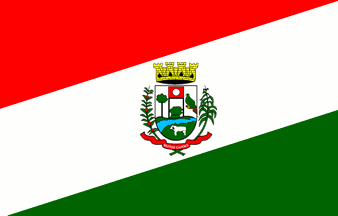 image by Dirk Schönberger,
29
February 2012
image by Dirk Schönberger,
29
February 2012Source: http://www.muitoscapoes.rs.cnm.org.br

Last modified: 2020-07-31 by ian macdonald
Keywords: rio grande do sul | muitos capões |
Links: FOTW homepage |
search |
disclaimer and copyright |
write us |
mirrors
 image by Dirk Schönberger,
29
February 2012
image by Dirk Schönberger,
29
February 2012
Source:
http://www.muitoscapoes.rs.cnm.org.br
The municipality of Muitos Capões (2,988 inhabitants in 2010; 11,931 ha) is
located 200 km of Porto Alegre.
Muitos Capões emerged around the chapel
dedicated to St. Anthony of Muitos Capões, erected on a plot offered by Manuel
Martins de Barros and his wife, Polidora Barros, and consecrated on 13 June
1901.
The district of Muitos Capões was established by Municipal Act No. 52
issued on 18 October 1917.
http://www.muitoscapoes.rs.gov.br/
Municipal website
Ivan Sache, 31 July 2020
The flag of Muitos Capões is prescribed by Municipal Law No. 15 promulgated
on 28 May 1997.
Article 1.
The flag of the municipality of Muitos
Capões shall have for official colors green, white and red, and shall be
composed of three panels, inspired by the design of the flag of Rio Grande do
Sul and the colors of the flag of Portugal, representing:
a) Green (vert): a
symbol of honor, civility, courtesy, glee, and abundance; green is also the
symbol of hope, as the mountains and greening fields in spring promising profuse
harvests.
b) White is a symbol of peace, friendship, integration, work and
community harmony.
c) Red (gules) is a symbol of dedication, patriotic love,
audacity, intrepidity, courage and valiance.
Article 2.
The flag shall
obey the following rules.
I. The flag shall be composed of three panels;
green, white and red in usual shades, green and red forming two right-angled
triangles and white a quadrilateral ascending between the two triangles, the
green triangle's right angle being placed in the flag's upper left corner and
the red triangle's right angle in the flag's lower right corner.
II. The flag
shall feature in the center a white panel charged with the municipal coat of
arms.
Article 3.
I. The flag's width shall be of 14 units.
II. The
flag's length shall be of 20 units.
III. The coat of arms shall have a width
of 7 units, leaving 3 units above and beneath it.
IV. The lesser side of the
green right-angled triangle, placed on left top, shall be exactly of 7 units.
This holds true for the lesser side of the red right-angled triangle, placed on
right bottom.
V. The lesser sides of the ascending white quadrilater&l placed
between the two right-angled triangles shall also be of 7 units.
https://leismunicipais.com.br/a/rs/m/muitos-capoes/lei-ordinaria/1997/2/15/lei-ordinaria-n-15-1997-institui-a-bandeira-do-municipio-de-muitos-capoes-e-da-outras-providencias
Leis Municipais database
The coat of arms of Muitos Capões is
prescribed by Municipal Law No. 14 promulgated on 28 May 1997.
Article 1.
A classical Flemish-Iberian shield surmounted by a mural crown argent with six
towers, four visible. In base a field vert (green) symbolizing Campos de Cima de
Serra, charged with river Saltinho that crosses the municipality and a bovine,
representing cattle-breeding. In the center, a stylized capão [isolated group of
trees], the municipality's namesake. In chief's center, a field gules (red)
charged with the symbol of food industry. Dexter on a field argent, a Brazilian
pine symbolizing the native forests. Sinister, a red-spectacled amazon,
symbolizing the municipality's ecology. The shield supported dexter and sinister
by maize and apple proper. Beneath the shield a scroll gules (red) inscribed in
letters argent (silver) the toponym "MUITOS CAPÕES" surrounded by date "29/12"
and year "1995".
The coat of arms has the following symbolic
interpretation:
a) The classical Flemish-Iberian shield, used to represent
the arms of Muitos Capões, originating from Germany and primarily introduced to
Spain during the struggle against the Moors, was subsequently introduced to
Portugal, namely to represent arms of domains, and eventually adopted by
Brazilian heraldry to evoke the colonizing race and main builder of the nation;
b) The mural crown surmounting the shield is the universal symbol of coat of
arms of domains; or with six towers, four visible in perspective, it classifies
the town as of third rank or municipal seat. The port gules (red) represent the
proper qualities of the leaders of the community;
c) Argent (silver) is a
symbol of peace, friendship, work, prosperity and religious feeling.
d) The
shield features in the center a stylized capão, the symbol and main geographical
characteristic of the municipality and its namesake.
e) The base vert (green)
recalls Campos de Cima da Serra, crossed by a fess azure (blue) representing the
municipality's main river, the Saltinho. The green field is charged with a
bovine, representing the important production sector and the municipality's
rural origins.
f) Vert (green) is a symbol of honor, civility, courtesy,
glee, abundance; green also represents hope as the greening fields in spring
promising profuse harvests.
Dexter on a field argent (silver), a Brazilian
pine symbolizes the region's native forests. Sinister a red-spectacled amazon
recalls that the municipality maintains the biggest reserve for this bird in Rio
Grande do Sul.
g) In chief's center, on a field gules (red) is featured the
symbol of food industry, recalling the potential of increase of the region's
economic activity by its important production sector.
h) The outer ornaments
recall the main products of the generous and fertile soil, apple and maize.
i) On a scroll gules (red), in letters argent (silver), the identifying toponym
"MUITOS CAPÕES" surrounded by "29/12", the day of creation of the municipality,
and "1995", its year of political emancipation.
https://leismunicipais.com.br/a/rs/m/muitos-capoes/lei-ordinaria/1997/2/16/lei-ordinaria-n-16-1997-institui-o-brasao-municipal-de-muitos-capoes-e-da-outras-providencias
Leis Municipais database
Ivan Sache, 31 July 2020